2024年安徽省中考九年级英语二轮专题复习 完形填空阅读理解专项突破六 信息归纳型阅读(共30张PPT)
文档属性
| 名称 | 2024年安徽省中考九年级英语二轮专题复习 完形填空阅读理解专项突破六 信息归纳型阅读(共30张PPT) | 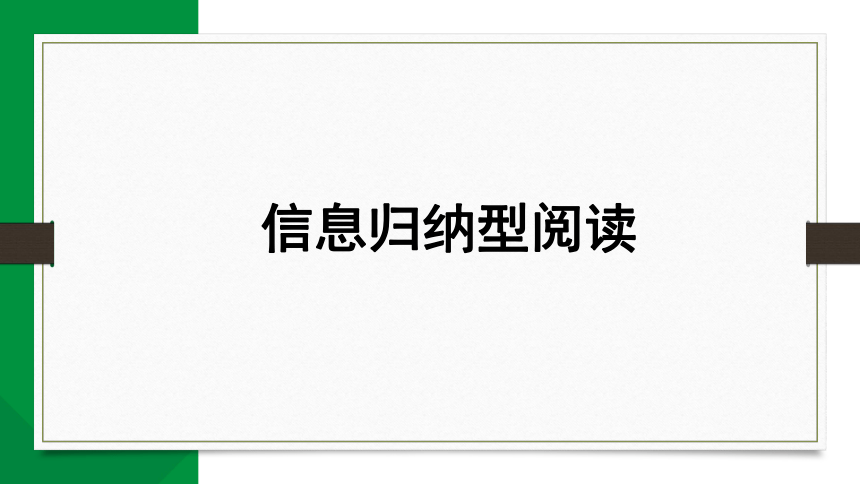 | |
| 格式 | pptx | ||
| 文件大小 | 4.5MB | ||
| 资源类型 | 教案 | ||
| 版本资源 | 通用版 | ||
| 科目 | 英语 | ||
| 更新时间 | 2024-04-30 17:28:10 | ||
图片预览

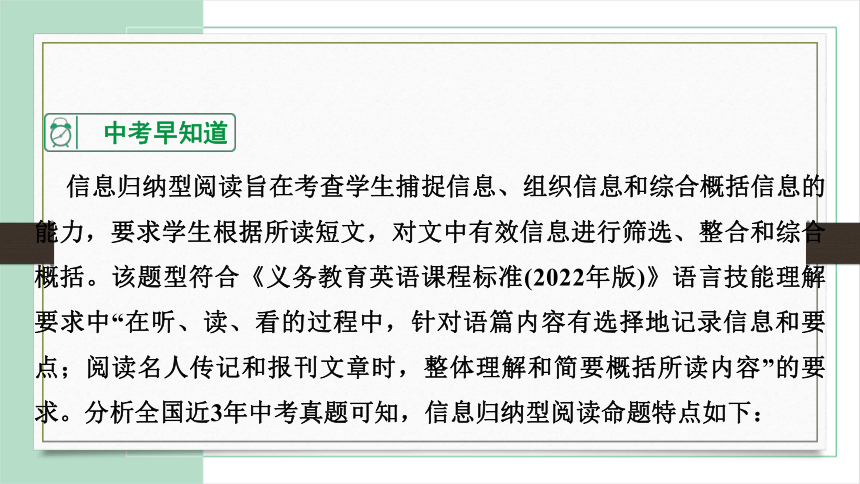
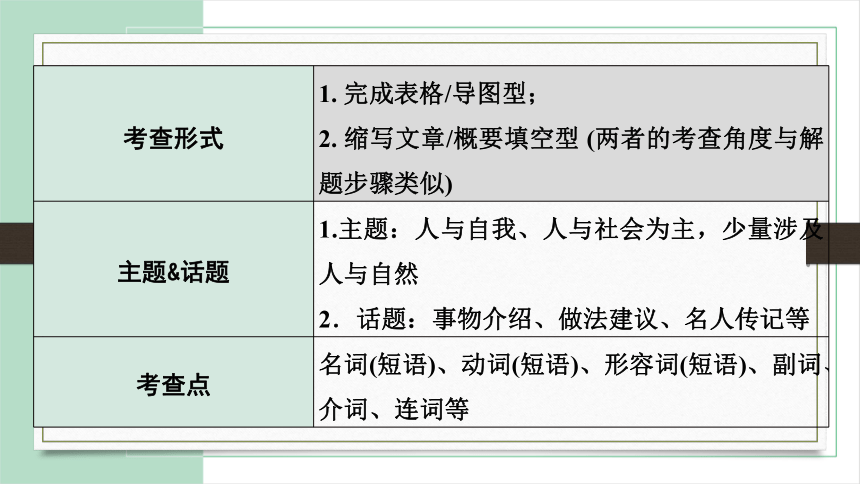

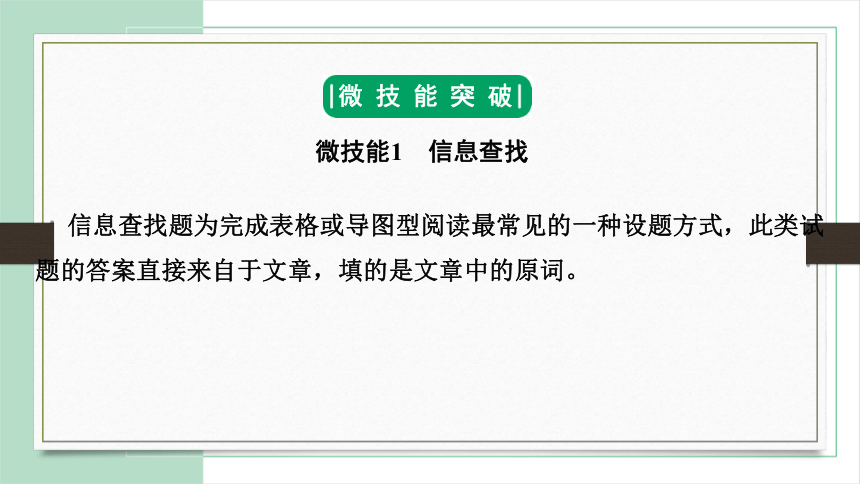
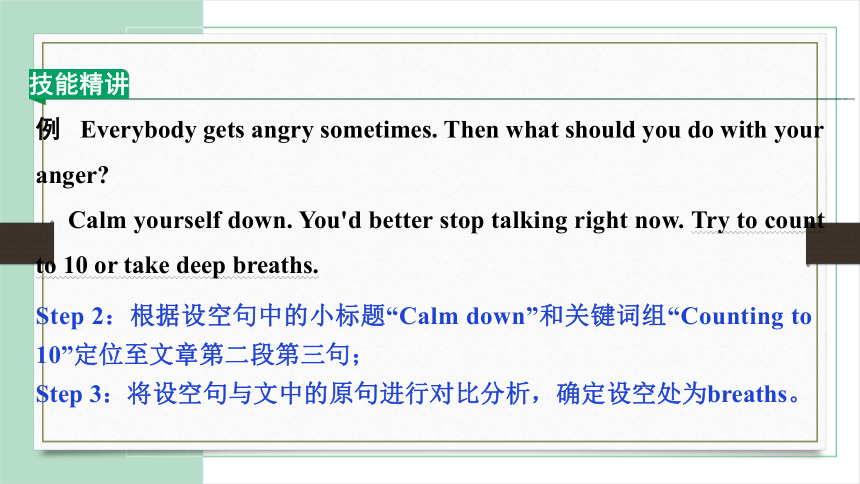
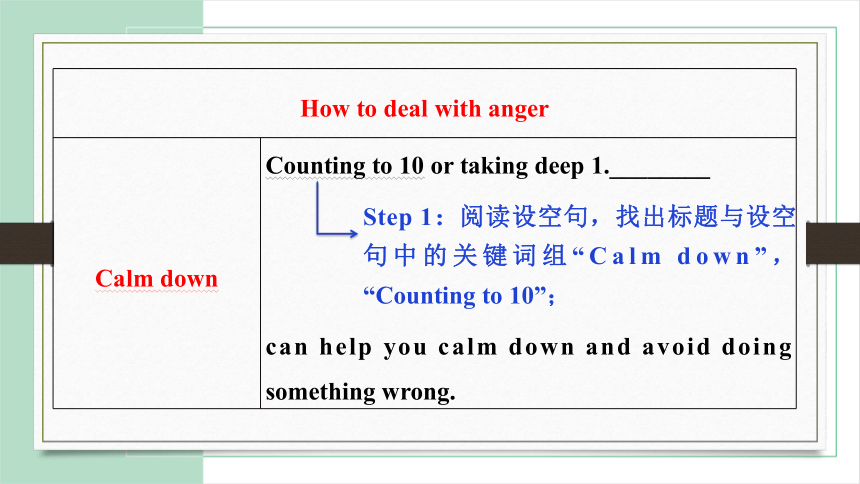
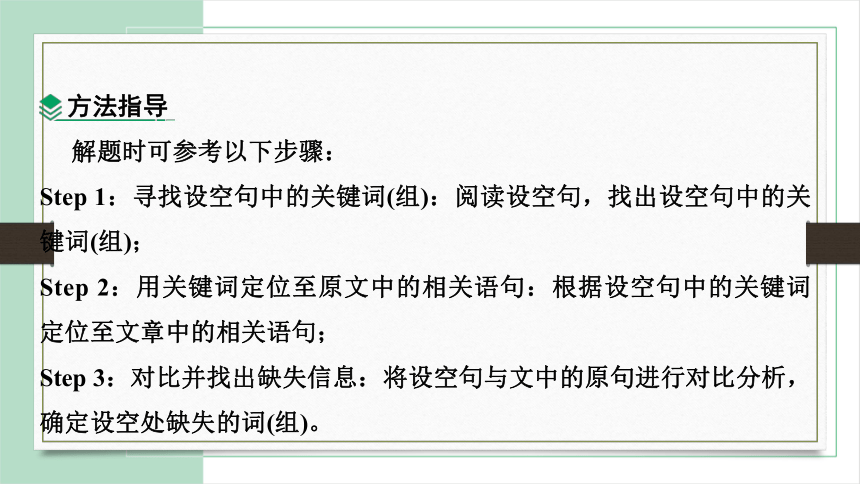

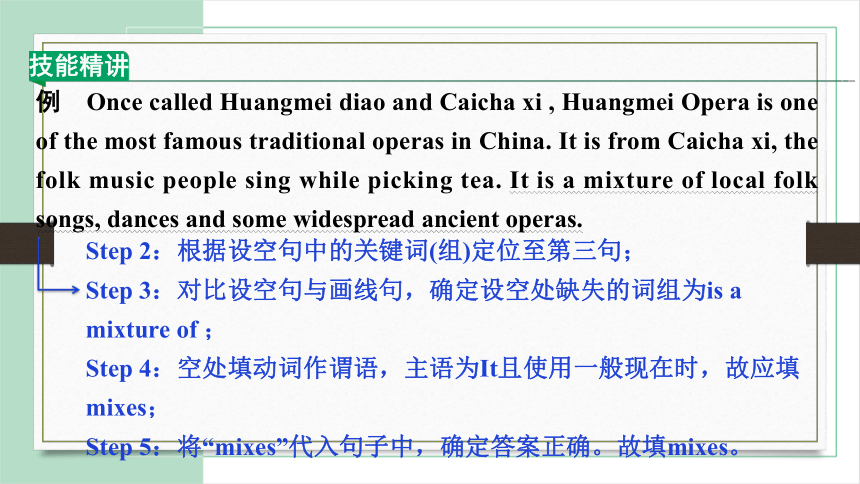
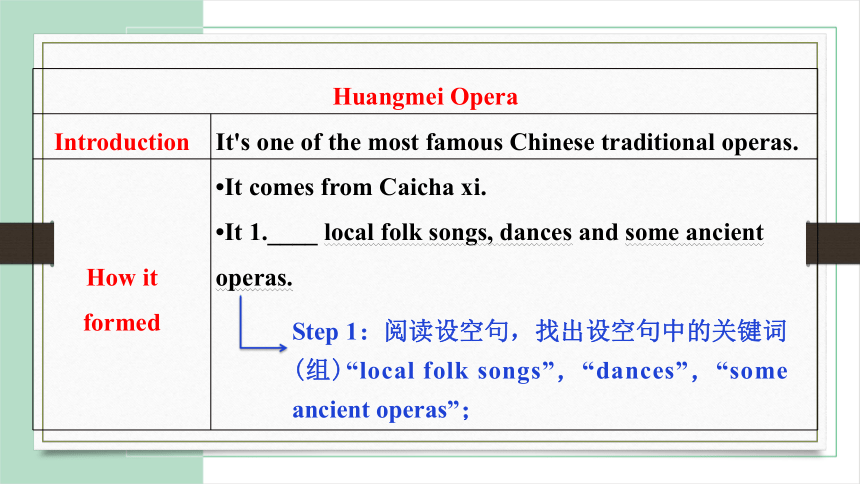
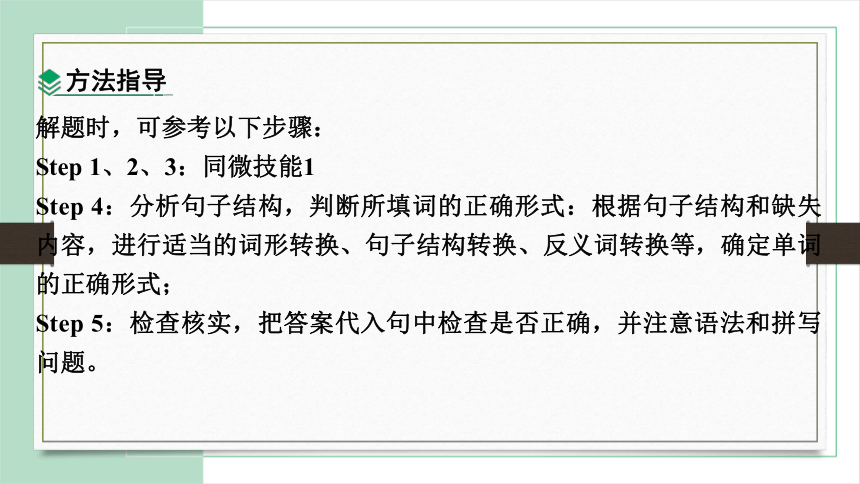
文档简介
(共30张PPT)
信息归纳型阅读
信息归纳型阅读旨在考查学生捕捉信息、组织信息和综合概括信息的能力,要求学生根据所读短文,对文中有效信息进行筛选、整合和综合概括。该题型符合《义务教育英语课程标准(2022年版)》语言技能理解要求中“在听、读、看的过程中,针对语篇内容有选择地记录信息和要点;阅读名人传记和报刊文章时,整体理解和简要概括所读内容”的要求。分析全国近3年中考真题可知,信息归纳型阅读命题特点如下:
中考早知道
考查形式 1. 完成表格/导图型;
2. 缩写文章/概要填空型 (两者的考查角度与解题步骤类似)
主题&话题 1.主题:人与自我、人与社会为主,少量涉及人与自然
2.话题:事物介绍、做法建议、名人传记等
考查点 名词(短语)、动词(短语)、形容词(短语)、副词、介词、连词等
考查角度 信息查找(针对细节信息)、信息转换(词性/词形转换、同义/反义转换等)、信息归纳(针对主旨大意)等
语篇类型 语篇类型呈多样化趋势,除常规文本外,还涉及多模态语篇(图文结合)、邮件、对话、网页等
信息查找题为完成表格或导图型阅读最常见的一种设题方式,此类试题的答案直接来自于文章,填的是文章中的原词。
微技能突破
微技能1 信息查找
例 Everybody gets angry sometimes. Then what should you do with your anger
Calm yourself down. You'd better stop talking right now. Try to count to 10 or take deep breaths.
技能精讲
Step 2:根据设空句中的小标题“Calm down”和关键词组“Counting to 10”定位至文章第二段第三句;
Step 3:将设空句与文中的原句进行对比分析,确定设空处为breaths。
How to deal with anger
Calm down Counting to 10 or taking deep 1.________
can help you calm down and avoid doing something wrong.
Step 1:阅读设空句,找出标题与设空句中的关键词组“Calm down”,“Counting to 10”;
解题时可参考以下步骤:
Step 1:寻找设空句中的关键词(组):阅读设空句,找出设空句中的关键词(组);
Step 2:用关键词定位至原文中的相关语句:根据设空句中的关键词定位至文章中的相关语句;
Step 3:对比并找出缺失信息:将设空句与文中的原句进行对比分析,确定设空处缺失的词(组)。
方法指导
信息转换题比信息查找题难度要大,此类试题的答案不能在文章中找到原词,需要将文章中的信息进行转换,从而得出正确答案。
微技能2 信息转换
例 Once called Huangmei diao and Caicha xi , Huangmei Opera is one of the most famous traditional operas in China. It is from Caicha xi, the folk music people sing while picking tea. It is a mixture of local folk songs, dances and some widespread ancient operas.
技能精讲
Step 2:根据设空句中的关键词(组)定位至第三句;
Step 3:对比设空句与画线句,确定设空处缺失的词组为is a mixture of ;
Step 4:空处填动词作谓语,主语为It且使用一般现在时,故应填mixes;
Step 5:将“mixes”代入句子中,确定答案正确。故填mixes。
Huangmei Opera
Introduction It's one of the most famous Chinese traditional operas.
How it formed It comes from Caicha xi.
It 1.____ local folk songs, dances and some ancient operas.
Step 1:阅读设空句,找出设空句中的关键词(组)“local folk songs”,“dances”,“some ancient operas”;
解题时,可参考以下步骤:
Step 1、2、3:同微技能1
Step 4:分析句子结构,判断所填词的正确形式:根据句子结构和缺失内容,进行适当的词形转换、句子结构转换、反义词转换等,确定单词的正确形式;
Step 5:检查核实,把答案代入句中检查是否正确,并注意语法和拼写问题。
方法指导
信息归纳题考查学生的归纳概括能力,此类试题一般会在表格的大标题或者表格的首行(列)的表头位置设空。学生在解答时要注意研究本行(列)的全部内容,所填词要能概括本行(列)的全部信息。
微技能3 信息归纳
例 Whether it's a friend, family member, or roommate, there is disagreement at some point between you. But how can we deal with the disagreement properly in our life
技能精讲
Step 2:设空位置是大标题,重点阅读文章的开头,根据画线句内容进行归纳可知,文章主要讲述的是处理分歧的方法,下文提到两种方法,故此处应填Ways;
Step 3:检查答案,将“Ways”代入标题中,确定答案正确。注意标题中实词首字母需大写。故填Ways。
Express thanks to them. Instead of arguing with them, say thanks. Saying “thank you” lets them know you accept the opinion that differs from your own.
Offer to listen to their opinions. Don't always express your opinions when people disagree with you. It's disarming(使人消气的) when you offer to let someone else have the first word.
The 1.________ to Deal with Disagreement
Express thanks Say thanks to let them know you accept different opinions.
Offer to listen to their opinions Offering to let someone else have the first word can be disarming.
Step 1:根据设空位置在大标题上可知,此处考查文章主题,分析句子结构可知,此处应填名词;
解题时可参考以下步骤:
Step 1:分析设空位置:若空设在表格的大标题上,则考的是文章主题;若设空处在某一列(行)的表头,则考的是某一部分/段落的主旨;并分析空处所缺成分;
Step 2:根据细节信息归纳总结主题:
①若是大标题:若是设空处为表格的大标题(文章的主题),重点阅读文章的开头和结尾段,同时结合表格中各个表头总结出主题;
②若是小标题:若是设空处在某一行/列的表头(文章某一部分/段落的主题),重点分析本行(列)的全部内容,归纳出主题;
Step 3:检查答案形式:若设空处为标题或者表头,要注意单词的首字母是否需要大写。
方法指导
技能演示
解答这一题型,需掌握各个微技能的特点和解答技巧,具体可参考以下解题步骤:
Experts who study body language agree that body language can tell us what someone is thinking or feeling.They also agree that there are general actions which have meanings to understand body language.
例题精讲
语篇解读 本文主要介绍了关于肢体语言的一些有趣的事实,旨在引导学生了解和学习肢体语言,增强人际沟通能力。
Experts say interpreting(解读) body language is not an exact science, but it gives clues(线索). And interpreting the clues can be interesting. Here are some of them.
Some 1.________ interpretations about body language
剖析:1. 信息归纳。根据第一段倒数第二句“And interpreting the clues can be interesting.”及后文内容可知,本文主要介绍了关于肢体语言的一些________事实。空处应填形容词修饰名词。故填__________。
有趣的
interesting
剖析:2. 信息转换。根据第一段第________句可知,肢体语言可以告诉我们别人正在想什么或有什么感觉,空处应填________作宾语,此处表示肢体语言可以展示人们的想法和________。根据thoughts可知此处应用可数名词复数形式。故填________。
Introduction Body language is shown as a clue to people's thoughts and 2.________.
一
名词
感受
feelings
Your mouth alone can say a lot. Smiling is probably the best known way you can communicate with your body, but a smile can mean different things. If the mouth is turned down, it may mean that the person is sad or even in pain. Biting the lip might mean someone is worried or nervous.
剖析:3. 信息查找。根据第二段第______句可知,笑容可以表示____
__________。空处应填________词。故填________。
二
不同
的含义
形容
different
The mouth Smiles have 3.________ meanings.
If the mouth is turned down, it may mean sadness or pain of a person.
Biting the lips means worry or nervousness.
Eyes can say a lot too. If a person looks directly into your eyes while having a conversation, this might mean that the person is interested and paying attention. But someone who stares(盯着看) at you for a long time may be unsafe. Blinking(眨眼) can be a clue too. People who blink rapidly may be feeling uncomfortable.
剖析:4. 信息查找。根据第三段第二句可知,________他人的眼睛意味着此人有兴趣且正在集中注意力。空处应填____词。故填________。
直视
副
directly
The eye Looking 4.________ into others' eyes means the person is interested and paying attention.
People feel uncomfortable when blinking rapidly.
Besides your mouth and eyes, your eyebrows(眉毛) can express feelings too. When people raise their eyebrows, it may mean that they have doubts or are thinking about something. If someone has furrowed(皱起的) eyebrows, he or she may feel very angry.
剖析:5. 信息查找+信息转换。根据第四段第______句可知,当人们________眉毛时,可能意味着他们有疑虑或在思考什么。根据介词“like”和空后的“_________”可知,空处缺少________词。故填________。
二
扬起
furrowing
The eyebrow Eyebrows can express feelings like doubt or anger through movements like 5.________ or furrowing eyebrows.
动名
raising
实战演练
语篇类型:说明文 | 主题:如何更好地记笔记 | 词数:218 |
难度:★★★☆☆ | 建议用时:8′ |
[五育并举——智育]You already take many notes, but now you're wondering how to develop your note taking skills and start taking notes that are better for you. 1题Here are some note taking methods you can use.
Pay attention to key words. The most important change you can make is to pay attention to taking down key words. Write down the most relevant(相关的) keywords or phrases to the theme. 2题Don't waste time writing down information that you have already known. Pay attention to writing down new information that you've never learned before—this will be the most valuable for your note taking.
Use shorthand(速记).3题Developing your own pattern(模式) of shorthand writing can help you to write quickly and avoid falling behind. Try writing things like “wd” for “would”, “cd” for “could” and “w/” for “with”. Also, try to shorten long words that appear again and again.
Make your notes tidier. You will not go back and study your notes if they are difficult to read! 4题Always start on a fresh page.You'll find your notes much easier to read if you start on a fresh, blank page for each new class or theme. 5题It is also good to use different forms such as charts(表格) to remember key ideas.
本阅读语篇属于“人与自我”主题范畴下的“生活与学习”的主题群。介绍了三种记笔记的方法,给予学生实际可行的记笔记的方法,旨在引导学生在学习过程中掌握恰当的学习策略,从而高效学习。
素材解读
How to Take 1.________ Notes
Focus on key words Write down key words or phrases that are closely related to the topic.
Write down new information you have never learned before to 2.________ time and make notes valuable.
Use shorthand To write 3.________ and avoid falling behind,you should develop your own shorthand system.
Shorten long words that appear repeatedly throughout the class.
Make your notes tidier Start from a 4.________ page for each new class or theme.
Using different 5.________ helps to remember key ideas.
Better
save
quickly
fresh
forms
Do you have any other methods to take notes Share your methods with the class.
补充设问
信息归纳型阅读
信息归纳型阅读旨在考查学生捕捉信息、组织信息和综合概括信息的能力,要求学生根据所读短文,对文中有效信息进行筛选、整合和综合概括。该题型符合《义务教育英语课程标准(2022年版)》语言技能理解要求中“在听、读、看的过程中,针对语篇内容有选择地记录信息和要点;阅读名人传记和报刊文章时,整体理解和简要概括所读内容”的要求。分析全国近3年中考真题可知,信息归纳型阅读命题特点如下:
中考早知道
考查形式 1. 完成表格/导图型;
2. 缩写文章/概要填空型 (两者的考查角度与解题步骤类似)
主题&话题 1.主题:人与自我、人与社会为主,少量涉及人与自然
2.话题:事物介绍、做法建议、名人传记等
考查点 名词(短语)、动词(短语)、形容词(短语)、副词、介词、连词等
考查角度 信息查找(针对细节信息)、信息转换(词性/词形转换、同义/反义转换等)、信息归纳(针对主旨大意)等
语篇类型 语篇类型呈多样化趋势,除常规文本外,还涉及多模态语篇(图文结合)、邮件、对话、网页等
信息查找题为完成表格或导图型阅读最常见的一种设题方式,此类试题的答案直接来自于文章,填的是文章中的原词。
微技能突破
微技能1 信息查找
例 Everybody gets angry sometimes. Then what should you do with your anger
Calm yourself down. You'd better stop talking right now. Try to count to 10 or take deep breaths.
技能精讲
Step 2:根据设空句中的小标题“Calm down”和关键词组“Counting to 10”定位至文章第二段第三句;
Step 3:将设空句与文中的原句进行对比分析,确定设空处为breaths。
How to deal with anger
Calm down Counting to 10 or taking deep 1.________
can help you calm down and avoid doing something wrong.
Step 1:阅读设空句,找出标题与设空句中的关键词组“Calm down”,“Counting to 10”;
解题时可参考以下步骤:
Step 1:寻找设空句中的关键词(组):阅读设空句,找出设空句中的关键词(组);
Step 2:用关键词定位至原文中的相关语句:根据设空句中的关键词定位至文章中的相关语句;
Step 3:对比并找出缺失信息:将设空句与文中的原句进行对比分析,确定设空处缺失的词(组)。
方法指导
信息转换题比信息查找题难度要大,此类试题的答案不能在文章中找到原词,需要将文章中的信息进行转换,从而得出正确答案。
微技能2 信息转换
例 Once called Huangmei diao and Caicha xi , Huangmei Opera is one of the most famous traditional operas in China. It is from Caicha xi, the folk music people sing while picking tea. It is a mixture of local folk songs, dances and some widespread ancient operas.
技能精讲
Step 2:根据设空句中的关键词(组)定位至第三句;
Step 3:对比设空句与画线句,确定设空处缺失的词组为is a mixture of ;
Step 4:空处填动词作谓语,主语为It且使用一般现在时,故应填mixes;
Step 5:将“mixes”代入句子中,确定答案正确。故填mixes。
Huangmei Opera
Introduction It's one of the most famous Chinese traditional operas.
How it formed It comes from Caicha xi.
It 1.____ local folk songs, dances and some ancient operas.
Step 1:阅读设空句,找出设空句中的关键词(组)“local folk songs”,“dances”,“some ancient operas”;
解题时,可参考以下步骤:
Step 1、2、3:同微技能1
Step 4:分析句子结构,判断所填词的正确形式:根据句子结构和缺失内容,进行适当的词形转换、句子结构转换、反义词转换等,确定单词的正确形式;
Step 5:检查核实,把答案代入句中检查是否正确,并注意语法和拼写问题。
方法指导
信息归纳题考查学生的归纳概括能力,此类试题一般会在表格的大标题或者表格的首行(列)的表头位置设空。学生在解答时要注意研究本行(列)的全部内容,所填词要能概括本行(列)的全部信息。
微技能3 信息归纳
例 Whether it's a friend, family member, or roommate, there is disagreement at some point between you. But how can we deal with the disagreement properly in our life
技能精讲
Step 2:设空位置是大标题,重点阅读文章的开头,根据画线句内容进行归纳可知,文章主要讲述的是处理分歧的方法,下文提到两种方法,故此处应填Ways;
Step 3:检查答案,将“Ways”代入标题中,确定答案正确。注意标题中实词首字母需大写。故填Ways。
Express thanks to them. Instead of arguing with them, say thanks. Saying “thank you” lets them know you accept the opinion that differs from your own.
Offer to listen to their opinions. Don't always express your opinions when people disagree with you. It's disarming(使人消气的) when you offer to let someone else have the first word.
The 1.________ to Deal with Disagreement
Express thanks Say thanks to let them know you accept different opinions.
Offer to listen to their opinions Offering to let someone else have the first word can be disarming.
Step 1:根据设空位置在大标题上可知,此处考查文章主题,分析句子结构可知,此处应填名词;
解题时可参考以下步骤:
Step 1:分析设空位置:若空设在表格的大标题上,则考的是文章主题;若设空处在某一列(行)的表头,则考的是某一部分/段落的主旨;并分析空处所缺成分;
Step 2:根据细节信息归纳总结主题:
①若是大标题:若是设空处为表格的大标题(文章的主题),重点阅读文章的开头和结尾段,同时结合表格中各个表头总结出主题;
②若是小标题:若是设空处在某一行/列的表头(文章某一部分/段落的主题),重点分析本行(列)的全部内容,归纳出主题;
Step 3:检查答案形式:若设空处为标题或者表头,要注意单词的首字母是否需要大写。
方法指导
技能演示
解答这一题型,需掌握各个微技能的特点和解答技巧,具体可参考以下解题步骤:
Experts who study body language agree that body language can tell us what someone is thinking or feeling.They also agree that there are general actions which have meanings to understand body language.
例题精讲
语篇解读 本文主要介绍了关于肢体语言的一些有趣的事实,旨在引导学生了解和学习肢体语言,增强人际沟通能力。
Experts say interpreting(解读) body language is not an exact science, but it gives clues(线索). And interpreting the clues can be interesting. Here are some of them.
Some 1.________ interpretations about body language
剖析:1. 信息归纳。根据第一段倒数第二句“And interpreting the clues can be interesting.”及后文内容可知,本文主要介绍了关于肢体语言的一些________事实。空处应填形容词修饰名词。故填__________。
有趣的
interesting
剖析:2. 信息转换。根据第一段第________句可知,肢体语言可以告诉我们别人正在想什么或有什么感觉,空处应填________作宾语,此处表示肢体语言可以展示人们的想法和________。根据thoughts可知此处应用可数名词复数形式。故填________。
Introduction Body language is shown as a clue to people's thoughts and 2.________.
一
名词
感受
feelings
Your mouth alone can say a lot. Smiling is probably the best known way you can communicate with your body, but a smile can mean different things. If the mouth is turned down, it may mean that the person is sad or even in pain. Biting the lip might mean someone is worried or nervous.
剖析:3. 信息查找。根据第二段第______句可知,笑容可以表示____
__________。空处应填________词。故填________。
二
不同
的含义
形容
different
The mouth Smiles have 3.________ meanings.
If the mouth is turned down, it may mean sadness or pain of a person.
Biting the lips means worry or nervousness.
Eyes can say a lot too. If a person looks directly into your eyes while having a conversation, this might mean that the person is interested and paying attention. But someone who stares(盯着看) at you for a long time may be unsafe. Blinking(眨眼) can be a clue too. People who blink rapidly may be feeling uncomfortable.
剖析:4. 信息查找。根据第三段第二句可知,________他人的眼睛意味着此人有兴趣且正在集中注意力。空处应填____词。故填________。
直视
副
directly
The eye Looking 4.________ into others' eyes means the person is interested and paying attention.
People feel uncomfortable when blinking rapidly.
Besides your mouth and eyes, your eyebrows(眉毛) can express feelings too. When people raise their eyebrows, it may mean that they have doubts or are thinking about something. If someone has furrowed(皱起的) eyebrows, he or she may feel very angry.
剖析:5. 信息查找+信息转换。根据第四段第______句可知,当人们________眉毛时,可能意味着他们有疑虑或在思考什么。根据介词“like”和空后的“_________”可知,空处缺少________词。故填________。
二
扬起
furrowing
The eyebrow Eyebrows can express feelings like doubt or anger through movements like 5.________ or furrowing eyebrows.
动名
raising
实战演练
语篇类型:说明文 | 主题:如何更好地记笔记 | 词数:218 |
难度:★★★☆☆ | 建议用时:8′ |
[五育并举——智育]You already take many notes, but now you're wondering how to develop your note taking skills and start taking notes that are better for you. 1题Here are some note taking methods you can use.
Pay attention to key words. The most important change you can make is to pay attention to taking down key words. Write down the most relevant(相关的) keywords or phrases to the theme. 2题Don't waste time writing down information that you have already known. Pay attention to writing down new information that you've never learned before—this will be the most valuable for your note taking.
Use shorthand(速记).3题Developing your own pattern(模式) of shorthand writing can help you to write quickly and avoid falling behind. Try writing things like “wd” for “would”, “cd” for “could” and “w/” for “with”. Also, try to shorten long words that appear again and again.
Make your notes tidier. You will not go back and study your notes if they are difficult to read! 4题Always start on a fresh page.You'll find your notes much easier to read if you start on a fresh, blank page for each new class or theme. 5题It is also good to use different forms such as charts(表格) to remember key ideas.
本阅读语篇属于“人与自我”主题范畴下的“生活与学习”的主题群。介绍了三种记笔记的方法,给予学生实际可行的记笔记的方法,旨在引导学生在学习过程中掌握恰当的学习策略,从而高效学习。
素材解读
How to Take 1.________ Notes
Focus on key words Write down key words or phrases that are closely related to the topic.
Write down new information you have never learned before to 2.________ time and make notes valuable.
Use shorthand To write 3.________ and avoid falling behind,you should develop your own shorthand system.
Shorten long words that appear repeatedly throughout the class.
Make your notes tidier Start from a 4.________ page for each new class or theme.
Using different 5.________ helps to remember key ideas.
Better
save
quickly
fresh
forms
Do you have any other methods to take notes Share your methods with the class.
补充设问
同课章节目录
- 词法
- 名词
- 动词和动词短语
- 动词语态
- 动词时态
- 助动词和情态动词
- 非谓语动词
- 冠词
- 代词
- 数词和量词
- 形容词副词及其比较等级
- 介词和介词短语
- 连词和感叹词
- 构词法
- 相似、相近词比较
- 句法
- 陈述句
- 一般疑问句和否定疑问句
- 特殊疑问句及选择疑问句
- 反意疑问句
- 存在句(There be句型)
- 宾语从句
- 定语从句
- 状语从句
- 主谓一致问题
- 简单句
- 并列句
- 复合句
- 主谓一致
- 主、表语从句
- 名词性从句
- 直接引语和间接引语
- 虚拟语气
- 感叹句
- 强调句
- 倒装句
- 祈使句
- 句子的成分
- 句子的分类
- 题型专区
- 单项选择部分
- 易错题
- 完形填空
- 阅读理解
- 词汇练习
- 听说训练
- 句型转换
- 补全对话
- 短文改错
- 翻译
- 书面表达
- 任务型阅读
- 语法填空
- 其他资料
